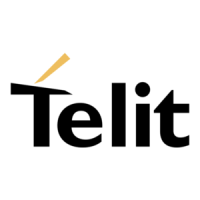ME910G1 HW Design Guide
1VV0301593 Rev.3 Page 77 of 97 2020-03-24
Thermal performance
FR4 is one of the most commonly used PCB materials, it is a flame retardant composite
material, composed by fiberglass-reinforced and epoxy laminate. One of the features of
the FR4, is to have a very low thermal conductivity. An inexpensive way to improve
thermal transfer for FR-4 PCBs is to add thermal vias - plated through-holes (PTH)
between conductive layers. Vias are created by drilling holes and copper plating them, in
the same way that a PTH or via is used for electrical interconnections between layers. An
array of plated through-hole thermal vias, should be located in the GND area underneath
Telit module of the PCB to provide a thermal connection from the PCB GND to additional
metal layers of the PCB.
The application PCB layout should include plated through-hole thermal vias for efficient
heat dissipation from the Telit module into the PCB. One of the following thermal via types
should be used:
• Open plated through-hole vias that will provide lower PCB fabrication costs but
may fill with solder.
• Plugged and capped plated through-hole vias that will provide higher PCB
fabrication costs but will not fill with solder.
Telit recommends creating areas of 10 mil (0.254-mm) vias arranged on a 25 mil (0.635-
mm) rectilinear matrix. The reason for this choice is the combination of cost, performance
and manufacturability. According to several PCB manufacturers, 10-mil holes and 25-mil
spacing are reasonable and repeatable production choice.
A uniform metal plating thickness on the PCB will ensure reliable, high Telit module solder
assembly yield.
Stencil
A silk-screen process will be required for the deposition of solder paste to the PCB, for
reflow of the Telit module to the PCB. The silk-screen process requires the use of an
aperture based metal stencil where solder paste is transferred through the apertures onto
the solder pads of the application PCB. To minimize solder voids and ensure maximum
electrical and thermal connectivity of the module to the PCB, large pads, solder volume,
and solder straining must be considered in the stencil design. The design and fabrication
of the stencil determines the quality of the solder paste deposition onto the PCB and the
resulting solder joint after reflow. The primary stencil parameters are aperture size,
thickness, and fabrication method.

